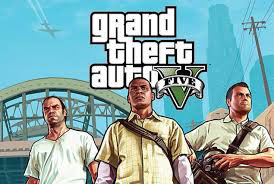Grand Theft Auto V: Life, Death, and Rebirth in San Andreas

September 30, 2013
There’s been a lot of talk this year about gaming’s “Citizen Kane moment,” meaning a release in the industry that could innovate it as Citizen Kane took innovative steps in the film industry. For it’s time, Citizen Kane was highly innovative on the technical front. The film industry generally hadn’t seen many of the techniques used in the film, and many techniques first seen in the film are still used today. And while it is my belief that gaming’s Citizen Kane moment has come and gone, (hello, Half-Life’s Mr. Freeman…) Grand Theft Auto V is the closest thing we have this year.
The area in which GTA V is most innovative is the storytelling method. In a first for the series, the story revolves around three protagonists: Michael De Santa, a retired bank robber who got a sweetheart deal with the FIB (GTA’s version of the FBI); Trevor Phillips, Michael’s former running buddy; and Franklin Clinton, a repo man whom Michael takes under his wing. You can switch between the three at any time, barring some missions and their aftermaths, and when you leave a character, you zoom out, Modern Warfare-style, and zoom in to your chosen character, and the character you left keeps going on with their lives.
You might leave Michael at his posh house to find Trevor in the midst of beating the snot out of a body builder, and come back twenty minutes later to find Michael in the middle of traffic, or playing golf. With the game’s long list of activities, our three protagonists could be found anything, from golfing to playing tennis to flying. This, along with the multitude of epic moments, both scripted and unscripted(such as one particular episode where, as Franklin, I hijacked a car only to find the driver packing an assault rifle, leading to a police chase halfway across the map) only serves to contribute to the sense that Rockstar North has created a living, breathing world in San Andreas that feels real.
San Andreas also has an amazing sense of place. Rockstar absolutely nailed the different ambiances of each section of the map without making the areas feel compartmentalized or making them feel like they don’t really fit together. The areas feel like they fit together organically, seamlessly flowing from city to country, and back again.
The sense of place is heightened by the absolutely fantastic graphics, which push the seven-year old PS3 and Xbox 360 hardware further than it probably has any right to. The state of San Andreas is always bustling, with multiple characters on the screen at once, and at night the countryside looks absolutely gorgeous. What’s most impressive, though, is how this is done without loading while the characters are alive. Once you die, the game has a loading screen, but it’s a negligible loading time, and the characters can enter shops and buildings without having wait through a loading screen a la Skyrim.
A living, breathing world with a sense of place doesn’t work if the characters and dialogue weren’t interesting or well written. Thankfully, at least the protagonists are. Trevor, in particular, is rather well-written and nuanced beyond his outwardly insane exterior, and this makes him one of the best characters in gaming history, and most definitely one of my favorites. So too, with the out-of-mission dialogue, which presents a knife-sharp satire of modern America, from the liberal-lampooning Impotent Rage cartoon, to the Weasel News radio bulletins, to the stellar talk shows and radio stations hosted by such folks as Kenny Loggins and DJ Pooh(the latter of whom wrote parts of GTA: San Andreas). The radio stations have something for everyone, and I was able to find at least one song on every station that I loved.
As for the controversy, sex, drugs, and brutal violence, that have been staples of the GTA series, all are in abundance in GTA V. It’s all handled tongue-in-cheek, but there is a particular mandatory torture scene that I found to be rather disturbing, although I found it necessary in the grand scheme of things.
However, the excellent writing generally doesn’t exist in the main story line (with the notable exception of Trevor, who delivers multiple fantastic bits throughout the story). Most of the main story line is boring, with side characters who are either annoying, (see: Jimmy, Michael’s 20-year old son, and Steve Haines, hotshot FIB agent for two prime examples), distasteful, or idiotic. I found myself skipping over most cutscenes in the game to get to the gameplay.
The mere fact that there are three protagonists instead of one is another major innovation for the series. The multiple protagonists mean that you no longer have the anti-violence cut scenes followed directly by random , hyper-violent killing sprees (I’m looking at you, GTA IV.) Each protagonist, then, fills a certain niche in mission terms: Trevor gets the mayhem, including a mission that involves the infiltration of and subsequent murder of an entire military base; Franklin gets most car-based missions, and Michael’s missions generally revolve around his mid-life crisis and his fraying relationships with his family. This arrangement is complemented by each protagonist’s special ability; Franklin can slow time while driving, which comes in handy as many times as you’d think in a game called Grand Theft Auto; Michael can slow time while shooting; and Trevor can enter the Orc’s Berserker mode from Skyrim.
The multiple protagonists also imbues the game’s missions with an abundance of variety beyond “run or drive here, shoot, and leave”. One mission has Michael racing Jimmy down Vespucci Beach on bikes, while another has Trevor impersonating a longshoreman and moving crates from bay to bay in order to prepare for a heist (seriously, that one’s more fun than I make it sound). The variety of missions in the game always keeps things fresh and interesting, and there’s very few, if any dull moments in the gameplay.
This mission variety, and the game’s grand scope as a whole, are best personified by the heists that form the game’s narrative climaxes. These multi-stage missions give the player a whole stable of options, from the approach to the crew, that allow for a lot of end-games in these particular missions. Do you go in stealthy, or fast and loud? Do you employ a weaker hacker, gunman, or driver in order to maximize your cut? The ability to replay every mission adds to the experimental nature of these heists, as you can try different combinations to see what best without fear of picking the “wrong” combo. Rockstar has also slain one of it’s longest-persisting demons: mission checkpoints. The missions are always well-checkpointed, making sure you don’t have to do the entire mission all over again, and there’s a skip option once you fail a section a certain number of times, which is a godsend, as it keeps the story’s flow, and kept me interested in the game, as it didn’t seem like there was a brick difficulty wall that kept me from progressing at any point. Not that the game is controller-breaking hard, but the ability to skip certain sections you have particular trouble at is always nice, and would be appreciated for gamers with disabilities such as myself.
The gameplay has seen much improvement since Grand Theft Auto IV. Rockstar has taken the games they’ve put out since GTA IV, and put the mechanics into GTA V. The vehicles, first and foremost, handle far, far, better than the boat-like handling of GTA IV, having tons more grip and adding a lot of fluidity in the driving sections, Rockstar North taking a cue from Midnight Club: LA. The cars still feel a little floaty, and they’re not as bound to road as, say, Sleeping Dogs, but Rockstar has found a good balance for the vehicle sections, making Franklin’s special ability, essentially a bullet time for cars, that much more effective and useful, and making the drives in between the wide breadth of surprisingly robust activities from golf to tennis to movie watching just as enjoyable as the activities themselves. The flying is also fantastic, although it takes little getting used to at first. It is, however, very fun once you do, and there’s an abundance of flying vehicles in the game.
The shooting has also taken many cues from it’s older Rockstar brothers, specifically Max Payne 3 and Red Dead Redemption. It feels snappy, fluid, and natural. The aiming is decent, with how accurate the shots are upon first aiming dictated by the shooting skill (what a concept!) and this can be improved by going to shooting ranges, and well, shooting. However, the aiming reticule, even on complex, is very small, and I lost track of it on multiple occasions.
There’s only one other blemish on the otherwise very good combat system: the melee combat. After playing Sleeping Dogs‘s Arkham Asylum-esque melee combat flow in an open world, it makes Grand Theft Auto V’s melee combat feel clumsy and cumbersome, and GTA V would’ve been better off with a better flowing melee combat system.
Overall, Grand Theft Auto V is an absolute masterpiece. It’s an extremely enjoyable videogame that shows Rockstar’s growth as a developer and refines everything that GTA IV had, and more. No game comes close to matching it’s scope and ambition, and I don’t think that a game will come close to pulling it off as successfully as Grand Theft Auto V has for a rather long time.


